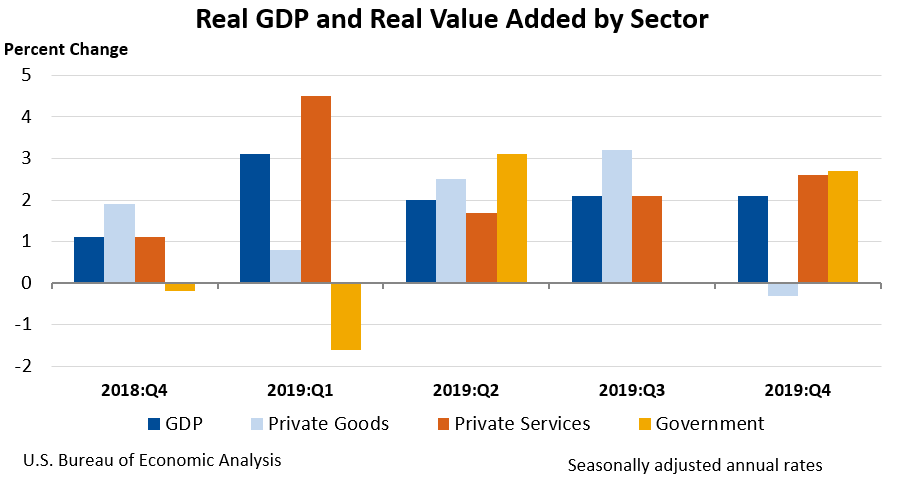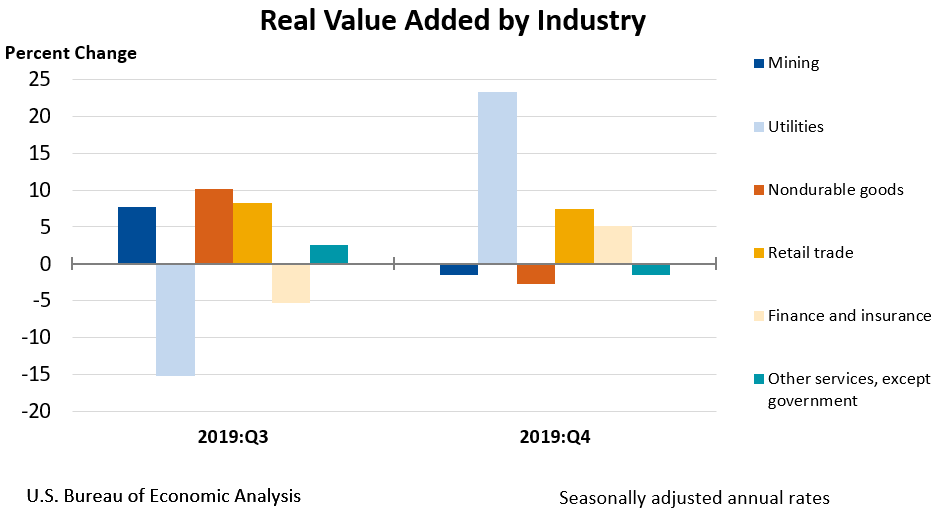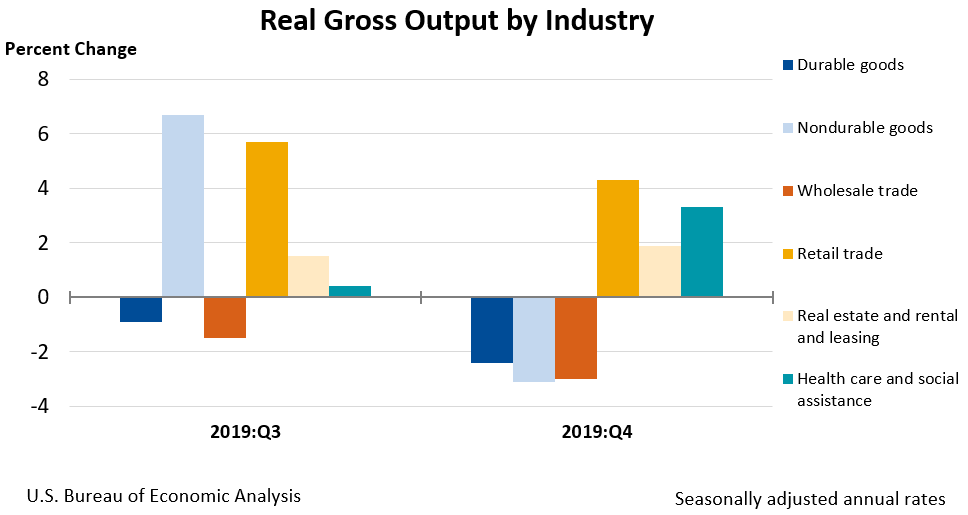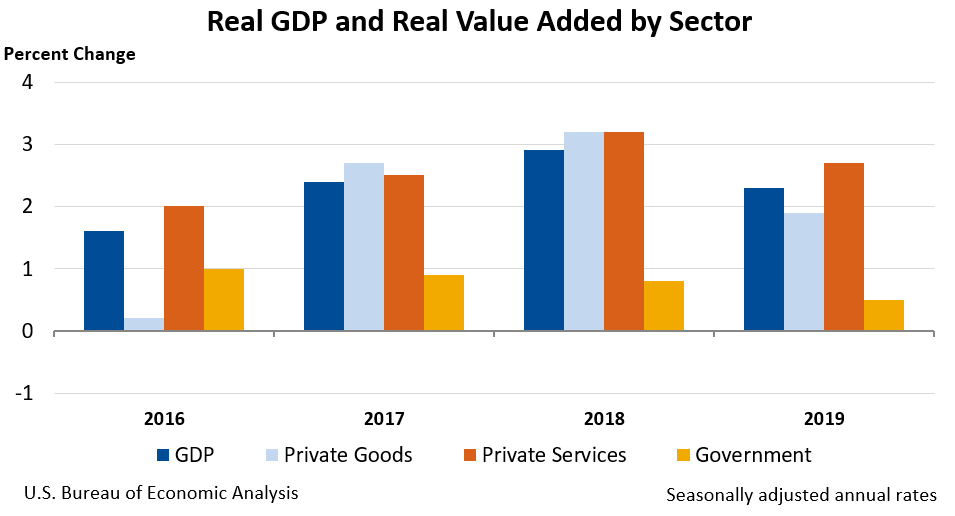News Release
Gross Domestic Product by Industry: Fourth Quarter and Year 2019
Retail trade, finance and insurance, and utilities were the leading contributors to the increase in U.S. economic growth in the fourth quarter of 2019, according to gross domestic product (GDP) by industry statistics released by the Bureau of Economic Analysis. An increase in private services-producing industries was partly offset by a slight decrease in goods-producing industries; the government sector increased. Overall, 17 of 22 industry groups contributed to the 2.1 percent increase in real GDP in the fourth quarter.
- For retail trade, real value added—a measure of an industry’s contribution to GDP—increased 7.4 percent in the fourth quarter, primarily reflecting an increase in other retail, which includes gasoline stations and nonstore retailers.
- Finance and insurance increased 5.1 percent in the fourth quarter. The largest contributor to the increase was securities, commodity contracts, and investments.
- Utilities increased 23.3 percent in the fourth quarter, primarily reflecting an increase in electric power generation.
- Nondurable goods manufacturing decreased 2.8 percent, primarily reflecting decreases in food and beverage and tobacco products as well as petroleum and coal products.
- Other services, except government, decreased 1.6 percent, in the fourth quarter. The largest contributors to the decrease were repair and maintenance as well as personal and laundry services.
- Mining decreased 1.6 percent, primarily reflecting a decrease in support activities for mining.
Other highlights
Real GDP growth in the fourth quarter was the same as that in the third quarter. Upturns in finance and insurance, utilities, and construction were largely offset by downturns in nondurable goods manufacturing and wholesale trade, and a slowdown in professional, scientific, and technical services.
- Construction increased 1.4 percent in the fourth quarter, after decreasing 2.1 percent in the third.
- Nondurable goods manufacturing decreased 2.8 percent, after increasing 10.1 percent, primarily reflecting a downturn in petroleum and coal products.
- Wholesale trade was unchanged in the fourth quarter, after increasing 3.0 percent in the third.
- Professional, scientific, and technical services increased 1.5 percent, after increasing 5.6 percent, primarily reflecting a slowdown in miscellaneous professional, scientific, and technical services.
Gross output by industry
Real gross output—principally a measure of an industry’s sales or receipts, which includes sales to final users in the economy (GDP) and sales to other industries (intermediate inputs)—increased 1.1 percent in the fourth quarter. This reflected an increase of 1.7 percent for the private services-producing sector, a decrease of 1.4 percent for the private goods-producing sector, and an increase of 2.8 percent for the government sector. Overall, 15 of 22 industry groups contributed to the increase in real gross output.
- Real gross output for health care and social assistance increased 3.3 percent in the fourth quarter, primarily reflecting an increase in ambulatory health care services.
- Retail trade increased 4.3 percent, primarily reflecting an increase in other retail, which includes gasoline stations and nonstore retailers.
- Real estate and rental and leasing increased 1.9 percent, primarily reflecting an increase in other real estate, which includes offices of real estate agents and brokers.
- Nondurable goods manufacturing decreased 3.1 percent, primarily reflecting a decrease in food and beverage and tobacco products manufacturing.
- Durable goods manufacturing decreased 2.4 percent, which was more than accounted for by a decrease in motor vehicles, bodies and trailers, and parts manufacturing.
- Wholesale trade decreased 3.0 percent in the fourth quarter.
2019 GDP by Industry
Real GDP increased 2.3 percent in 2019 (from the 2018 annual level to the 2019 annual level). The private goods- and services-producing sectors, as well as the government sector, contributed to the increase. Growth was widespread, with 20 of 22 industry groups contributing to the increase. Professional, scientific, and technical services; finance and insurance; and information were the leading contributors to the increase in real GDP in 2019.
- For professional, scientific, and technical services, real value added increased 5.5 percent in 2019, after increasing 5.2 percent in 2018. The 2019 increase primarily reflected increases in miscellaneous professional, scientific, and technical services as well as computer systems design.
- Finance and insurance increased 3.3 percent in 2019, after decreasing 1.9 percent in 2018. The 2019 increase followed two consecutive years of decline and primarily reflected an increase in insurance carriers and related activities.
- Information services increased 4.6 percent in 2019, after increasing 8.5 percent in 2018. The 2019 increase primarily reflected increases in data processing, internet publishing, and other information services as well as publishing industries.
***
Next release – July 6, 2020 at 8:30 A.M. EDT for:
Gross Domestic Product by Industry: First Quarter 2020



